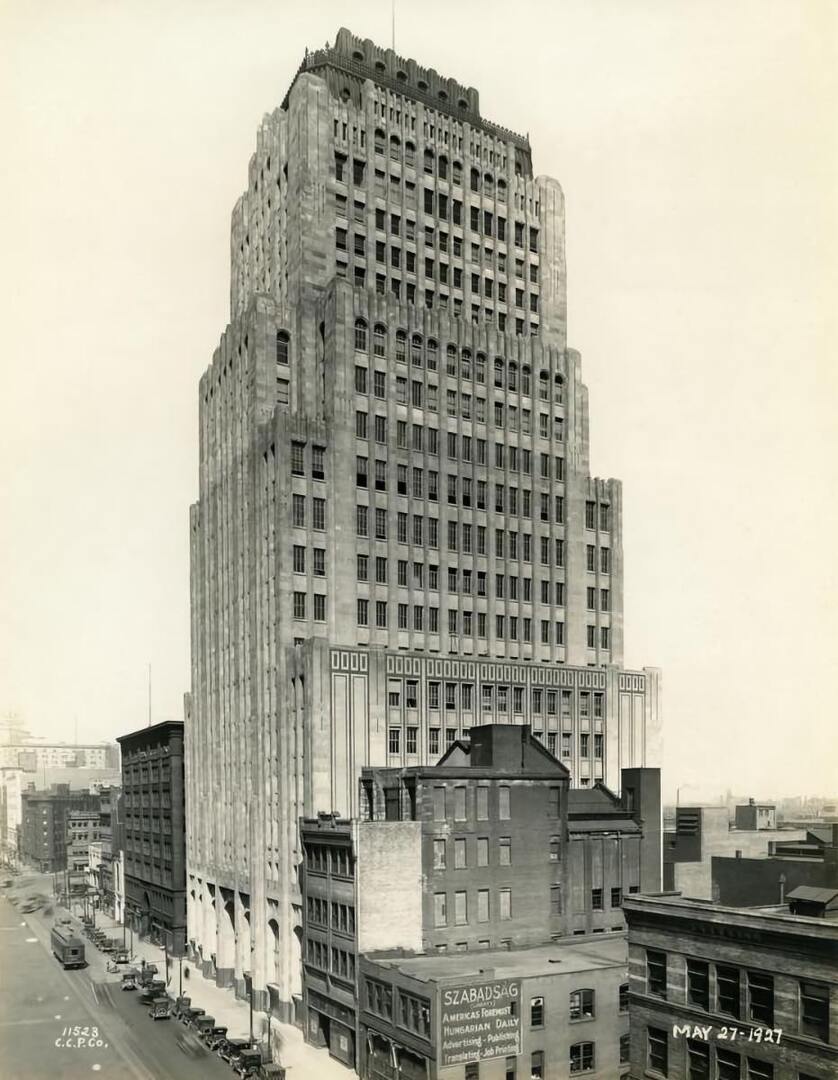
Although many Clevelanders may want to believe the oft-told but never-verified story that it inspired the Daily Planet building made famous by the Cleveland-born Superman comics, this Art Deco skyscraper has more demonstrable contributions to telecommunications advances. While these may seem mundane today, they made the Ohio Bell skyscraper a marvel in their day.
The Ohio Bell Telephone Building, now known as the AT&T Huron Road Building is one of the of the most recognizable buildings in the city of Cleveland. The building was the tallest in Cleveland upon its completion in 1927, towering over all other buildings in the downtown area. The building would be the tallest in Cleveland until the completion of the Terminal Tower in 1929. Designed by the Cleveland architectural firm Hubbell & Benes, the Ohio Bell Telephone Building is well known as one of Cleveland's most recognizable examples of an Art Deco architecture. This architectural artistic style started gaining traction in the 1920s and remained prevalent throughout the 1930s. With its great height and modern, angular appearance that exemplify the Art Deco style of architecture so popular at the time, the Ohio Bell Telephone Building stood tall as a symbol of pride for the citizens of Cleveland.
The building faced a tumultuous construction period. One strike after another threatened to prevent the building from ever being finished. One of the most notable strikes during construction occurred in October of 1926. When all was said and done, workers had halted work on the building for a total of three weeks. This strike could have very easily marked the end of construction completely, had there not been a court order from a common pleas judge in Washington, ordering the striking workers to return to work immediately. Not long after, the building was finally completed.
The Ohio Bell Telephone Building was the site of many innovations in the following decades. In 1949, a new relay system was underway that would allow long distance calls to be made from Cleveland to New York or Miami. This new system was installed in the Ohio Bell Telephone Building at a cost of $6.5 million. It was estimated at the time that this new system would be able to connect every major center in the country. The system utilized relay point towers that were constructed throughout the countryside. These “voice highways” were spaced roughly 25 miles apart and permited very high frequency radio waves to skip above obstructions to connect telephone calls. This system paved the way for further innovations in how we communicate with one another across the world.
Methods of call transmission continued to evolve in the 1970s. In December 1979, the Ohio Bell Telephone Building was having a new $40 million switching system installed. The “Super Switcher” occupied two floors of the building and was designed to route up to 550,000 calls an hour. This was far larger than the previous 60-minute record of 160,000 calls. Ohio Bell stated that the new system would speed up long distance connections and open up the ability to install new services in the next decade. Of the many innovations in telecommunications that occurred in the Ohio Bell Telephone Building, the Super Switcher was its most significant contribution.
Beyond its rather utilitarian history, the Ohio Bell Telephone Building also has a rich cultural history in the minds of Clevelanders. The creators of Superman, Jerry Siegel and Joe Shuster, grew up in Cleveland’s Glenville neighborhood. This local connection has caused many people in Cleveland to believe that the inspiration for the iconic Daily Planet skyscraper of comic book fame stemmed from the Ohio Bell Telephone Building. While true that the buildings are similar in appearance, there is little evidence to support this theory, and Siegel and Shuster have denied the connection.
Despite the fact that it could very possibly never have been constructed, the Ohio Bell Telephone Building is a repository of the history of advances in telecommunications. Even if its Superman credentials can't been verified, all who pass by and look up at this Art Deco landmark can know the Super Switcher and other Cleveland contributions to long-distance telecommunication.
Images







